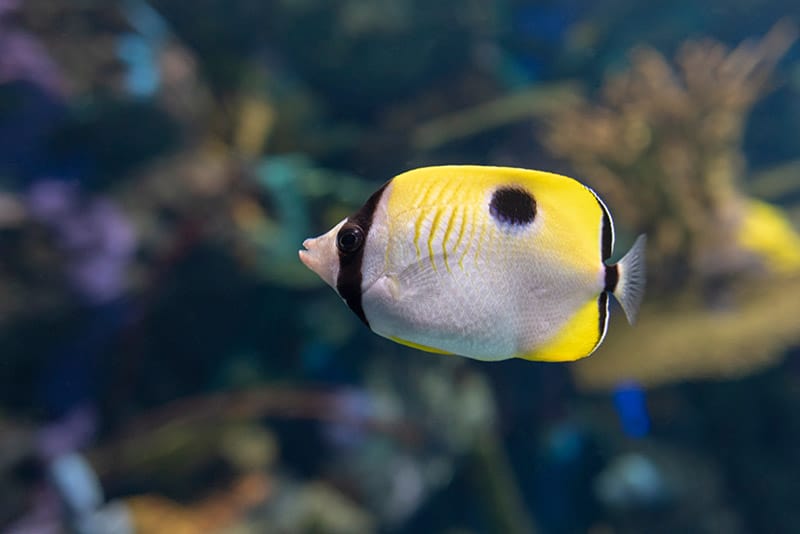The Teardrop Butterflyfish is a beauty that will tug at your heartstrings with its distinctive’tearing’ eyespot!
The Teardrop Butterflyfish Chaetodon unimaculatus is a widespread species. Itranges from the Indian Ocean at Christmas Island and the Cocos-Keeling Islands of Australia, all the wayacross the tropical Pacific to the Hawaiian Islands. This is a large handsome fish, reaching up to about 7 3/4 inches (20 cm), with a large hearty appetite to match. With its strong jawsit will eat just about anything ona coral-rich reef from hard and soft corals to all sorts of benthic invertebrates. As it heartily chomps on the delicate polyps of a coral its strong bitewill take chunks of the skeleton as well.
This is an attractively colored fishwith a bold pattern that’s easilyrecognized.It has a white body with bright yellows along its back and on the dorsal and anal fin. Those same fins are accented with a black vertical band running along the rear edge and there is another black band running through the eye.
However, the most distinguishing feature of this butterflyfish, and thus its namesake, is the tearing eyespot on the upper part of its body. The tearing of the eyespot is especially strong in juveniles. Adults become a bit more rugged looking with the tear beginning to fade, or only leaving a slight black smudge. In the largest individuals the mouth also begins to get a bit “deformed” from its voracious feeding habits. Other common names it is known by include Onespot Butterflyfish, Limespot Butterflyfish, One-spot Butterfly, Pacific Teardrop Butterflyfish, and Teardrop Coralfish.
This species is a member of a group of butterflyfishes that tentatively belong to the subgenus Lepidochaetodon, which may eventually become a distinct genus. This is a small group that consists of 8 species. Specimens like the photo above are from Australia and the Pacific islands and have a white ground color, while a very close relative to the Indian Ocean and the western portion of the Indo-Malayan Archipelago are yellow. The Indian Ocean variety are called the Yellow Teardrop Butterflyfish Chaetodon interruptus. The C. interruptus was previously considered a subspecies of C. unimaculatus, but is now considered to be a distinct species due to the yellow ground color and its range.
This Teardrop Butterflyfish is hardy and can be fairly easily adapted to life in the aquarium, making it a good choice for the beginner. In the wild, it spends most of its time in heavily populated coral areas eating stony and soft corals, sponges, algae, and polychaete worms (marine worms). With its hearty appetite and broad diet, it will readily accept most foods offered in captivity.
- For more information on keeping saltwater fish see: Marine Aquarium Basics: Guide to a Healthy Saltwater Aquarium
Teardrop Butterflyfish
Scientific Classification
| Kingdom: | Animalia |
| Phylum: | Chordata |
| Class: | Actinopterygii |
| Order: | Perciformes |
| Family: | Chaetodontidae |
| Genus: | Chaetodon |
| Species: | unimaculatus |
Teardrop Butterflyfish – Quick Aquarium Care
| Aquarist Experience Level: | Beginner |
| Aquarium Hardiness: | Moderately hardy |
| Minimum Tank Size: | 75 gal (284 L) |
| Size of fish: | 7.9 inches (19.99 cm) |
| Temperament: | Peaceful |
| Temperature: | 74.0 to 81.0° F (23.3 to 27.2° C) |
| Range ph: | 8.1-8.4 |
| Diet Type: | Omnivore |
- My Aquarium – Enter your aquarium to see if this fish is compatible!
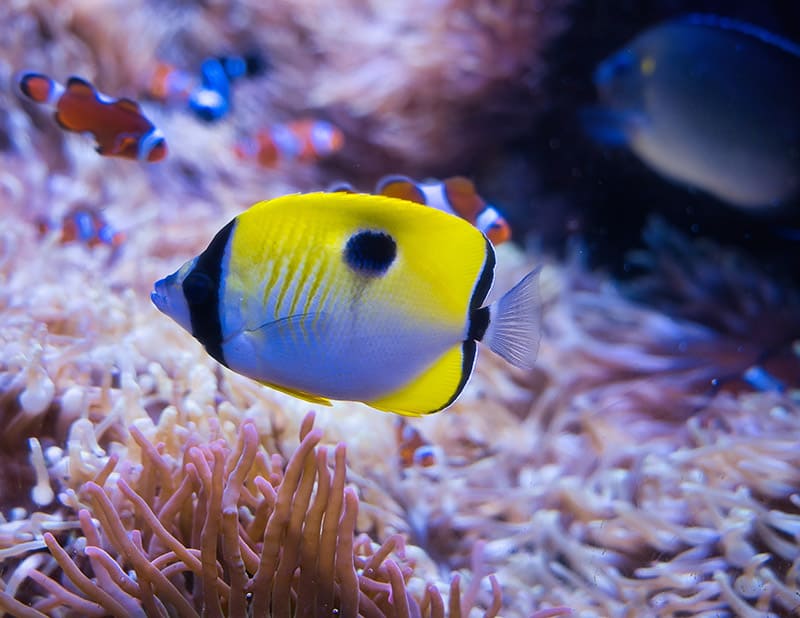
Habitat: Distribution / Background
The Teardrop Butterflyfish Chaetodon unimaculatus was described by Bloch in 1787. They have a very wide distribution. They are found from in the Indian Ocean at Christmas Island and the Cocos-Keeling Islands of Australia south to central New South Wales, Lord Howe Island, and Rapa Iti Island, north to southern Japan, and then east across the tropical Pacific to to Polynesia including the Hawaiian, Marquesas, Ducie, and Easter Islands. There are also some that occur in the Galapagos Islands of Ecuador.
This species is on the IUCN Red List as Least Concern (LC). They have a wide distribution and a large population. Although they are corallivorous with corals being are a large part of their diet, they have not declined in areas where there has been coral loss and there are no other major threats identified. Other common names they are known by include Onespot Butterflyfish, Limespot Butterflyfish, One-spot Butterfly, Teardrop Coralfish, and Pacific Teardrop Butterflyfish.
This species is a member of a group of butterflyfishes that tentatively belong to the subgenus Lepidochaetodon, which may become a distinct genus. This is a small group consisting of 8 species. It is closely related to the Yellow Teardrop Butterflyfish Chaetodon interruptus. The C. interruptus is found throughout the Indian Ocean and was previously considered a subspecies of C. unimaculatus, but is now considered to be a distinct species. It is a more distant relative of other species in this group like the very popular Klein’s ButterflyfishChaetodon kleinii and the Tahiti Butterflyfish Chaetodon trichrous. However it has been known to hybridize with C. kleinii in the Marshall Islands.
These butterflyfish are associated with coral rich reef areas, occurring on reef flats and exposed fore-reef slopes as well as patchy reefs or pinnacles in lagoons. They are found at depths between 1 – 197 feet (1 – 60 m), though adults are most often found between 65 – 197 (20 – 60 m) deep. They are a timid butterflyfish and generally not common. But when seen the adults are often in small groups of about 3 – 5 individuals or as pairs, and are occasionally seen alone. Juveniles on the other hand, are usually found alone.
Their diet is broad and quite variable depending upon where they occur. They will graze on both soft and hard corals, and when feeding on stony corals will crush and ingest chunks of the skeleton along with the polyps. They feed almost exclusively on Montipora corals in Hawaii, soft leather corals of the Sarcophyton and Sinularia genera in the western Pacific, hard corals in Moorea of French Polynesia, and in other places they feed on a wide range of coral species. They also eat filamentous algae, sponges, tunicates, polychaete worms, larger crustaceans, small clams, and even the feces of fish.
- Scientific Name: Chaetodon unimaculatus
- Social Grouping: Groups – Adults are usually seen in pairs or small groups, though sometimes are seen alone. Juveniles are solitary.
- IUCN Red List: LC – Least Concern
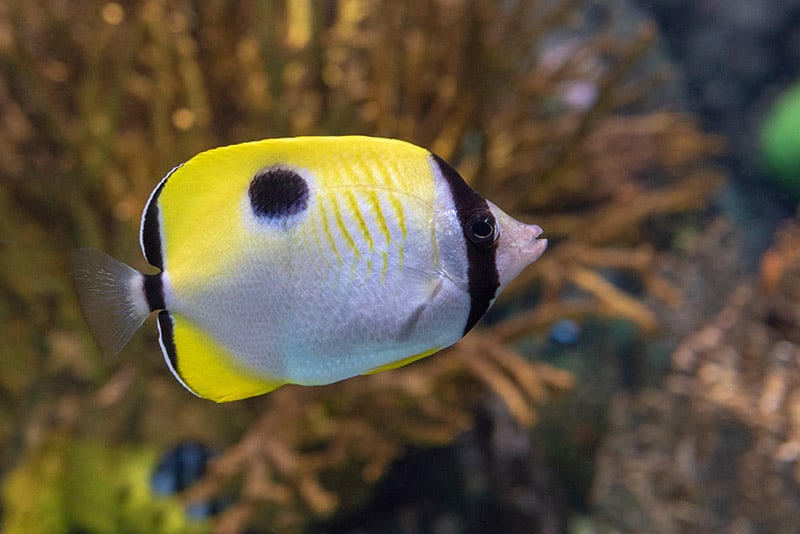
Description
The Teardrop Butterflyfish has the typical butterflyfish shape. It has laterally compressed disc-shaped body and a protruding snout with strong jaws. The dorsal fin is continuous and it has a rounded tail fin. This species can reach a length of about reaching up to about 7 3/4 inches (20 cm). In the largest individuals the mouth begins to get a bit “deformed” from its voracious feeding habits. The lifespan for most of the Chaetodon species is between 5 – 7 years, and can possibly be longer with proper care.
The adult C. unimaculatus has a white ground with bright yellows along its back and on the pelvic, dorsal, and anal fins. There is a black vertical band running through the eye and another along the rear edge of the dorsal and anal fin. As its name aptly implies, there is a dark tear shaped eyespot on the upper part of its body . The tail fin is transparent.
Juveniles are almost identical, except that the tearing of the eyespot is more pronounced, while on adults the tearing fades, becoming just a faint smudge.
- Size of fish – inches: 7.9 inches (19.99 cm)
- Lifespan: 5 years – The average lifespan Chaetodon species is between 5 – 7 years, and possibly longer with proper care.
Fish Keeping Difficulty
This is a durable Butterflyfish once it is acclimated and has a broad natural diet. It will take almost any foods offered in captivity so can be suggested for a beginning aquarist. It is not recommended for reef aquariums however, as is one of the most destructive species of butterflyfish. It will eat any corals, anemones, and mushroom anemones, and will snack on most other invertebrates, possibly even picking at large ornamentals.
- Aquarium Hardiness: Moderately hardy
- Aquarist Experience Level: Beginner
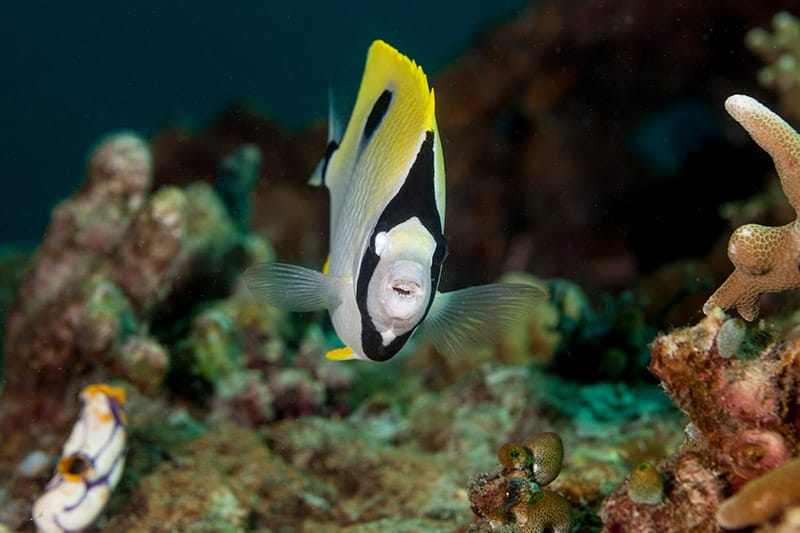
Foods and Feeding
The Teardrop Butterflyfish are omnivores, in the wild they feed on a broad range of coral species and other Cnidarians, algae and many non-coralline invertebrates. No special food is needed in the aquarium, they will readily accept a wide variety of foods. Offer Meaty foods, dried flakes, shrimps, and tablets and frozen foods of all kinds including Formula I, Formula II, Angel Formula and spirulina. Several sponge based frozen foods are now available and can also be fed to butterflyfish. Japanese Nori will also be favored. Feed it at least twice a day, and if it is a tiny juvenile feed it three to four times everyday.
| Diet Type: | Omnivore |
| Flake Food: | Yes |
| Tablet / Pellet: | Yes |
| Live foods (fishes, shrimps, worms): | Some of Diet |
| Vegetable Food: | Some of Diet |
| Meaty Food: | Some of Diet |
| Feeding Frequency: | Several feedings per day – Offer various foods quite frequently at first. Once acclimated adults need at least 2 feedings a day and juveniles need 3 to 4. |
| Diet Type: | Omnivore |
Aquarium Care
No special care or technique is needed to maintain this fish in the aquarium. Frequent water changes are not necessary, rather normal water changes at 10% biweekly or 20% monthly are fine. Sudden massive water changes can cause trouble.
- Water Changes: Bi-weekly – Change 10% biweekly or 20% monthly, avoid sudden massive water changes.
Aquarium Setup
These fish need plenty of space to accommodate their size and to swim. As they can reach a almost 8 inches in length, a 75 gallon tank is the minimum suggested size. The tank should be established and a good algae growth will help in keeping this fish. It should be well decorated with lots of rocks creating numerous places for retreat and lots of rubble. They also need plenty of open space for swimming.
This fish is a coral eater, nipping the polyps of soft and hard coral species as well as crushing and ingesting the skeletons of hard corals. It will also snack on mushrooms and mushroom anemones and will tear apart most other invertebrates it finds. Consequently it is not recommended for reef aquariums.
| Minimum Tank Size: | 75 gal (284 L) |
| Suitable for Nano Tank: | No |
| Live Rock Requirement: | Typical Plus Hiding Places |
| Substrate Type: | Mix – Sand + Coral |
| Lighting Needs: | Moderate – normal lighting – It can also be kept under bright light as long as some dark areas are provided. |
| Temperature: | 74.0 to 81.0° F (23.3 to 27.2° C) |
| Specific gravity: | 1.020-1.025 SG |
| Range ph: | 8.1-8.4 |
| Brackish: | No |
| Water Movement: | Weak – Water movement is not a significant factor. It can tolerate a rather strong flow but slow-moving water is recommended. |
| Water Region: | All – It swims freely and usually spends time in the open water. |
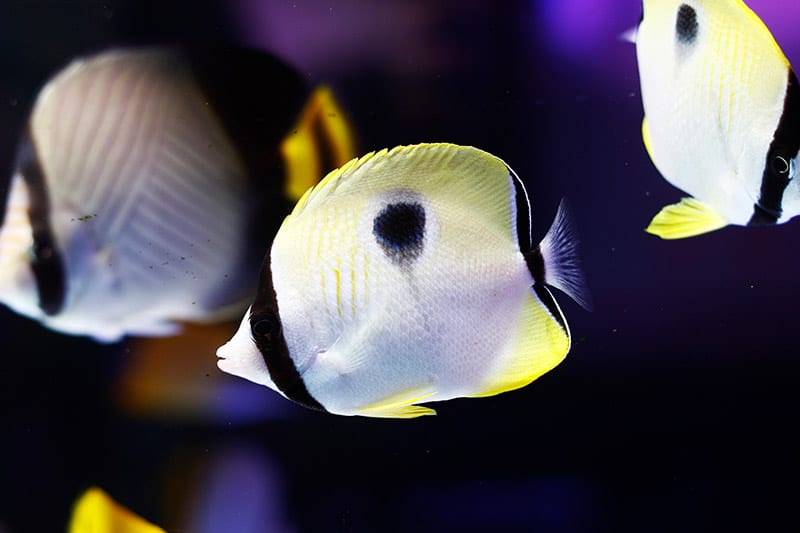
Social Behaviors
The Teardrop Butterflyfish is best kept in a large fish only community tank. This fish is non-aggressive to other fish, and will basically ignore its other non-related tankmates. They get along with most other marine fishes, basically just ignoring them, and with moderately aggressive tankmates they are quite capable of holding their own. They can be kept singly, or in pairs or as a small group if the tank is large enough, and with other butteflyfish. They are not suited for the reef aquarium as they will feed on coral polyps, anemones, and a wide range of other invertebrates and crustaceans,
Smaller non-aggressive fishes like cardinalfish, gobies, tilefish, fairy basslets, fairy and flasher wrasses are good candidates as tank mates. Larger and rather territorial angelfish like Pomacanthus and Holacanthus can be kept together with this species as well as other angelfish like members of Centropyge, Apolemichthys, Genicanthus, Chaetodontoplus and Pygoplites can also be good tank mates. Small but very territorial fishes like dottybacks should be avoided. Such fish as Basses or scorpionfish, even if they are small enough, should be avoided as should larger frogfishes that can swallow everything.
- Venomous: No
- Temperament: Peaceful
- Compatible with:
- Same species – conspecifics: Yes
- Peaceful fish (gobies, dartfish, assessors, fairy wrasses): Safe
- Semi-Aggressive (anthias, clownfish, dwarf angels): Safe
- Monitor
- Large Semi-Aggressive (tangs, large angels, large wrasses): Safe
- Large Aggressive, Predatory (lionfish, groupers, soapfish): Threat
- Monitor
- Anemones: Threat
- Mushroom Anemones – Corallimorphs: Threat
- LPS corals: Threat
- SPS corals: Threat
- Gorgonians, Sea Fans: Threat
- Leather Corals: Threat
- Soft Corals (xenias, tree corals): Threat
- Star Polyps, Organ Pipe Coral: Threat
- Zoanthids – Button Polyps, Sea Mats: Threat
- Sponges, Tunicates: Threat
- Shrimps, Crabs, Snails: Threat
- Starfish: Threat
- Feather Dusters, Bristle Worms, Flatworms: Threat
- Clams, Scallops, Oysters: Threat
- Copepods, Amphipods, Mini Brittle Stars: Threat
Sex: Sexual differences
No sexual difference is noted for this species. Butterflyfish species studied up to this time indicate that these fish are gonochoristic, meaning that each fish is either a male or a female and they do not change sex.
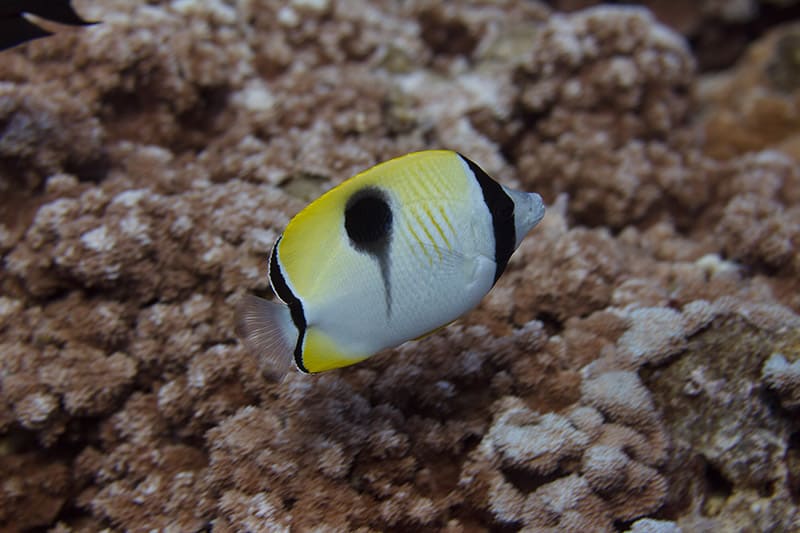
Breeding / Reproduction
This species has not been cultivated in captivity. In the wild butterflyfish are pelagic spawners that release many tiny eggs into the planktonic water column where they float with the currents until they hatch. Once hatched the fry are in a post-larval where their body, extending from the head, is covered with large bony plates.
Marine butterflyfish have not reportedly been spawned successfully in captivity. There are however, reports of some success in rearing wild collected larvae of some of the corallivorous butterflyfish. It is hoped these captive reared fish will be adapted to accept aquarium foods, and thus broaden the species selections that can be sustained in captivity. For more information see, Marine Fish Breeding: Butterflyfish.
- Ease of Breeding: Unknown
Fish Diseases
The Teardrop Butterflyfish are generally hardy and problems with disease are minimal in a well maintained aquarium. Any additions to a tank can introduce disease, so it’s advisable to properly clean or quarantine anything that you want add to an established tank prior to introduction.
Diseases that marine Butterflyfish are susceptible to include Marine Ich(white spot disease), Marine Velvet, Uronema marinum, and Lymphocystis. Some can be treated successfully with medical care or copper drugs, but some species hate sudden changes of water including pH, temperature, or any drug treatment. In the wild a cleaner wrasse (Labroides sp.) will help them by taking parasites from their bodies, however these wrasses are extremely difficult to sustain in captivity. Alternative fish such as Neon Gobies (Gobiosoma spp.) can help them by providing this cleaning service in the home aquarium.
This butterflyfish is a stony coral eater and it can also be sensitive to some drugs. Be sure to observe this fish closely when medicating it, so you can remove it if it shows signs of stress. For information about saltwater fish diseases and illnesses, see Aquarium Fish Diseases and Treatments.
Availability
This fish is generally available online and occasionally in pet stores. It is moderately expensive with prices ranging depending on size and area of origination.
- Beginner Fish – Saltwater fish for beginners
- Community Fish – Peaceful Saltwater fish
- Hardy Fish – Hardy Saltwater fish
- Similar size fish – Fish that are 1 inch bigger or smaller
- Coldwater Fish – Looking for cold water fish?
Featured Image Credit: Miroslav Halama, Shutterstock
